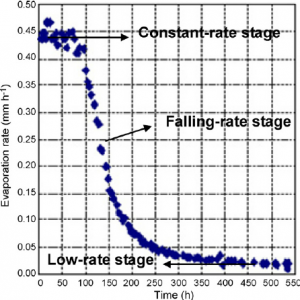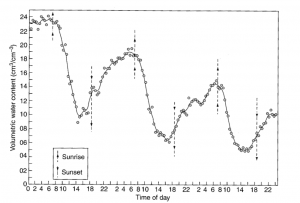10.3 Evaporation in the Absence of a Water Table
When there is no near-surface water source, like a shallow water table, then evaporation cannot be steady state. Rather, as evaporation proceeds, the soil dries out, and evaporation eventually slows down. This transient, or time-varying, evaporation is the most common type of evaporation and is often divided into three stages:
- the first constant-rate stage,
- the second falling-rate stage, and
- the third low-rate stage.
During the first stage, the evaporation is limited by the evaporative demand, and the soil is able to transmit water to the soil surface at a rate adequate to meet that demand. If the evaporative demand is constant during this stage, then the evaporation rate will be constant as well. That is the situation illustrated in the laboratory data shown in Fig. 10‑3 [4]. However, in field situations the evaporative demand typically follows a daily cycle, with peak demand near midday and minimum values at night. Thus, in the field first stage evaporation is not truly constant.
The second stage of evaporation begins when the soil is no longer able to transmit water to the surface at a rate adequate to keep up with the evaporative demand. At the moment, the evaporation process switches from demand-limited to soil-limited, and the evaporation rate begins to fall (Fig. 10‑3). The third stage of evaporation occurs after the soil surface has become so dry that the hydraulic conductivity is essentially zero. Since the soil can no longer transmit liquid water to the surface, the evaporation process can only proceed by sub-surface evaporation, followed by water vapor transport through the soil surface layer to the atmosphere. During this low-rate stage, evaporation is reduced to a small fraction of the rate observed when the surface was wet.

The duration of each stage of evaporation depends on the soil hydraulic properties and the evaporative demand. When the evaporative demand is high, the first stage may last only a few hours and the second stage only a few days. When the evaporative demand is lower, the first stage may last for days and the second stage for weeks.
Again, it is worthwhile to emphasize that strong daily cycles of evaporative demand often result in repeated drying and rewetting of the soil surface and in evaporation dynamics more complex than the three distinct stages just described. In a classic 1971 field experiment near Phoenix, Arizona, a loam soil was irrigated, and then detailed measurements of soil water content versus depth were recorded by soil sampling every 30 minutes for approximately 15 days [5]! A portion of this remarkable data set is shown in Fig. 10‑4, and the pronounced daily wetting and drying of the soil surface is striking. Because of the strong daily cycles, the author concluded that the concept of three stages of soil evaporation appeared to have little meaning under these field conditions.


